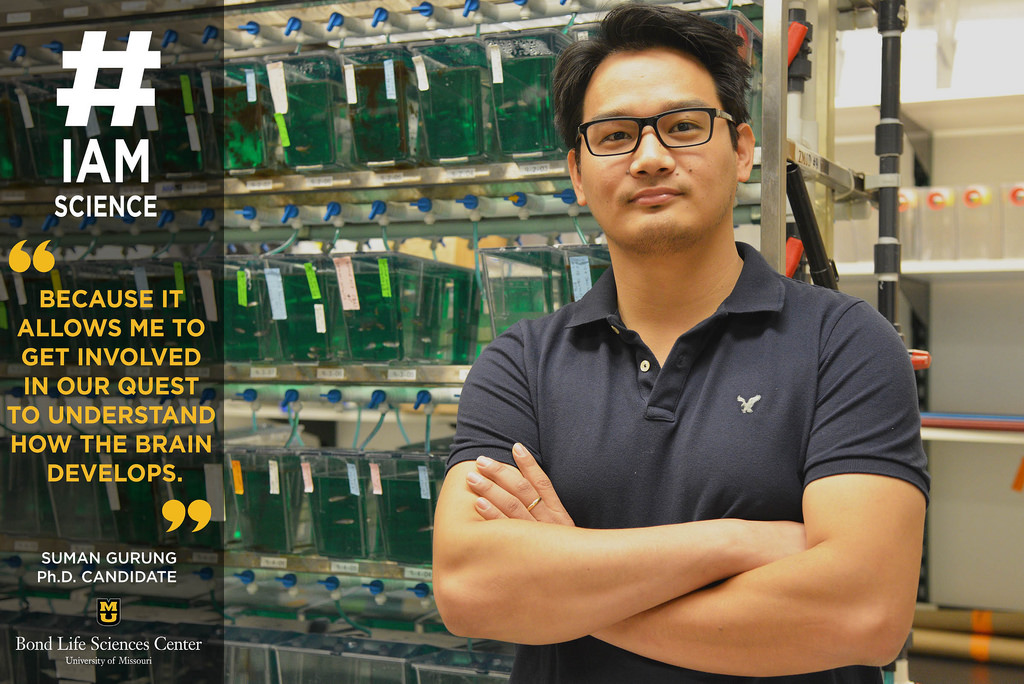Published on

Suman Gurung, a Developmental Neurology Ph.D candidate, stands in front of the zebra fish he studies. Gurung works in the Chandrasekhar lab at Bond LSC. | photo by Allison Scott, Bond LSC
By Allison Scott | Bond Life Sciences Center
#IAmScience “because it allows me to get involved in our quest to understand how the brain develops.”
The smallest discoveries often yield the greatest rewards when it comes to science. Suman Gurung, a Ph.D. candidate in the Division of Biological Sciences, is well aware of that.
Gurung works to uncover those small discoveries through the movement of neurons in the brain as a member of Anand Chandrasekhar’s lab in Bond LSC.
“We study how neurons migrate in the brains of zebrafish,” Gurung said. “We look at how they go from where they’re born to where they finally end up and make different connections.”
Those connections play a big part in how the brain works and can tell scientists like Gurung a lot about its inner workings. The paths the neurons follow, though, aren’t absolute.
“We investigate the cell behaviors of facial branchiomotor neurons in the zebrafish hindbrain to understand how migrating neurons respond to the environment,” Gurung said. “We also investigate the interaction between facial branchimotor neurons and the neighbouring cells as they migrate to their final destination where they carry out their function.”
It might sound complicated, but those nerves primarily control muscle movement in the jaw of the fish.
Knowing why these neurons take the paths they do could reveal significant information about the inner workings of the brain.
“We’re interested in how neurons in the vertebrate brain know when to start, which direction to take, and when to stop migration” Gurung said. “We’re interested in these questions because many human brain disorders are the result of failed neuron migration, which often result in poor motor function, seizures and impaired cognitive development.”
This work centers in a single room in the basement of Bond LSC where rows of fish tanks contain thousands of zebrafish.
“Zebrafish are transparent, and also easier and cheaper to maintain [than other lab animal models],” Gurung said. “They produce a lot of offspring and their development happens outside the mother’s body, meaning we can physically see the live growth and migration of neurons.”
The fish also develop rather quickly, requiring only about 20 hours for their branchiomotor neurons to complete migration. These neurons start migrating around 18 hours after fertilization and complete their migration by 48 hours after fertilization, meaning Gurung and his lab must work quickly.
“We monitor the fish all the time,” Gurung said. “The lab members take turns caring for the fish, everything from feeding to cleaning tanks and checking water quality.”
That makes the research an around the clock activity. However, Gurung doesn’t mind the extra effort because of how connected he is to the work.
“When you work with the same fish, they become your babies,” Gurung said. “Everything is dependent upon the health of those fish, so keeping them healthy is essential.”
Having grown up in Nepal, Gurung came to the United States right after graduating from high school. Before ending up at Mizzou, Gurung attended the University of Nevada-Reno and earned a combined bachelor’s and master’s degree in biotechnology.
After completing his Ph.D., Gurung wants to stick with research.
“My long-term goal is to establish a career on a research-intensive path,” Gurung said. “Since I enjoyed teaching and mentoring undergraduates and junior colleagues during my graduate studies, I would like to hold a position with ample opportunity for mentoring and teaching.”
Ultimately, he’s excited about the future and the opportunities working at Bond LSC has granted him.
“I am fascinated by this opportunity that I have,” Gurung said. “To work in a lab, do research and tackle things the way we do is incredible. Growing up, I never thought I’d be able to do all of this.”